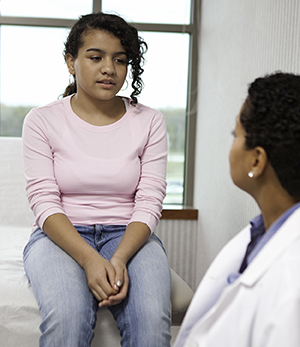For Teens: Understanding HPV
For Teens: Understanding HPV
Human papillomavirus (HPV) is a virus that causes warts. It can be hard to detect, so many people never even know they have it. Some strains (types) of HPV may cause warts on the hands, legs, or other parts of the body. These can spread from person to person. Other strains of HPV cause warts in the genital area. Of these, a few strains can lead to cancer in the area where the uterus and vagina meet (the cervix) and the genitals, as well as some other places. Treating genital forms of HPV now can help prevent serious health problems in the future.
HPV is very common in both men and women and it can’t be cured. But there are treatments to remove warts.
What to look for
Some types of HPV cause warts. Others don’t. You can also have more than one type of HPV at a time. Here are some things to look out for:
Painless lumps or bumps. Warts may be bumpy, cauliflower-shaped, or flat. They can appear in or around the genitals or anus.
In girls, an abnormal Pap smear. Over time, HPV can cause abnormal cell changes (dysplasia) on the cervix. These increase your chances of getting cervical cancer. If you have an abnormal Pap smear, you may need a follow-up test to look for HPV.
How warts form
HPV lives inside skin and mucous membrane, including in the mouth and vagina. The virus can make skin cells reproduce more often than they should. These extra skin cells build up into warts.
HPV invades the skin.
DNA from the virus enters skin cells.
HPV causes infected skin cells to multiply and form warts.
The virus sheds, allowing it to be passed to others.
Treatment
Warts can be removed by a doctor. But the virus stays in the body. Both males and females can pass on HPV even when warts aren’t visible. If a female has an abnormal Pap smear, she may have other tests or treatment. Regular checkups can help make sure the cervix is healthy.
If you don’t get treated
HPV can cause cell changes that increase the chance of getting cervical cancer. This health problem can sometimes cause death. If you are sexually active, you may need to be screened for cervical cancer by having a Pap test and an HPV test. At age 21, it's recommended women have a Pap test. A Pap test can help spot warning signs of cancer early on—when treatments work best. Discuss cervical cancer screening guidelines and tests with your doctor.
HPV can also raise the risk for cancers in boys and men. These cancers include anal, penile, and head and neck cancers. Although boys and men aren't at risk for cervical cancer, they can pass on HPV to their partners.
Prevention
An HPV vaccine helps protect both men and women from the types of HPV that are most likely to lead to cancer. Most boys and girls should get the HPV vaccine around age 11 to 12. It can be given as early as age 9. The vaccine is given in two doses, with the second dose 6 to 12 months after the first. Teens ages 15 and older and young adults who missed getting the vaccine should get a 3-dose series. The second dose is given 1 to 2 months after the first dose, and third dose 6 months after the first. Ask your doctor whether this vaccine is right for you.
Updated:
November 06, 2017
Sources:
Recommendations for the use of human papillomavirus vaccines. UpToDate., Virology of human papillomavirus infections and the link to cancer. UpToDate.
Reviewed By:
Adler, Liora C, MD,Fetterman, Anne, RN, BSN,Image reviewed by StayWell art team.,Pierce-Smith, Daphne, RN, MSN, CCRC
